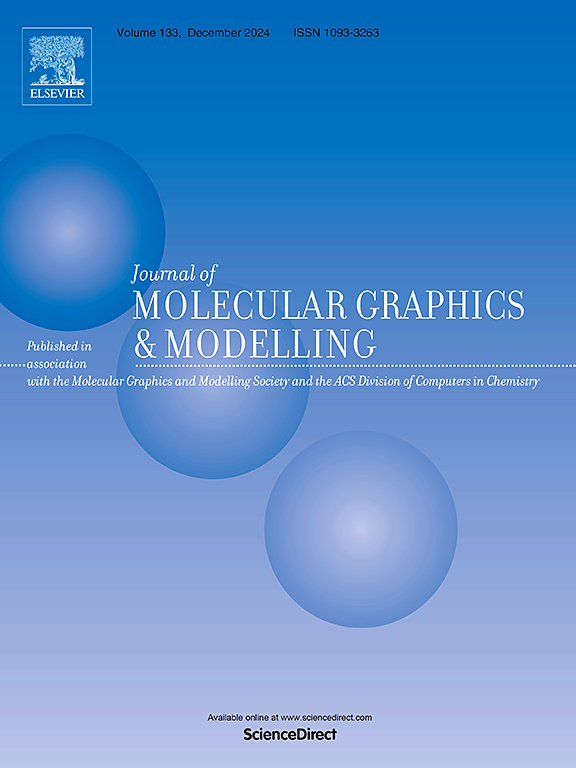Unraveling the molecular mechanism of temperature-induced destabilization in the PqsE-RhlR complex of Pseudomonas aeruginosa at mammalian body temperature through classical molecular dynamics and metadynamics
IF 2.7
4区 生物学
Q2 BIOCHEMICAL RESEARCH METHODS
引用次数: 0
Abstract
PqsE and RhlR, key regulators of the Pseudomonas aeruginosa quorum sensing (QS) system, form a hetero-tetrameric complex essential for controlling the expression of virulence factors such as pyocyanin. The interaction between the PqsE homodimer and the RhlR homodimer bound to C4-HSL, enables RhlR to bind low-affinity promoters, thereby influencing gene regulation. Recent studies suggest that RhlR transcriptional activity is modulated by temperature, exhibiting higher activity at environmental temperatures (25 °C) compared to mammalian body temperature (37 °C). However, the molecular mechanisms underlying this temperature-dependent regulation remain unclear. This study aims to explore how temperature influences the structural stability of the PqsE/RhlR/C4-HSL complex using molecular dynamics (MD) simulations at 25 °C and 37 °C. The results demonstrate that the overall stability of the complex decreases at 37 °C, with global RMSD analysis indicating greater fluctuations compared to 25 °C. Further RMSD analysis of PqsE and RhlR separately revealed that the destabilization is more pronounced in RhlR, particularly in its DNA-binding domain (DBD), where significant flexibility and destabilization were observed at 37 °C, as indicated by the higher RMSF values. Free energy landscape analysis confirmed increased conformational flexibility in the RhlR at higher temperatures, potentially impairing its DNA-binding ability. To further investigate this, metadynamics simulations were performed for PqsE/RhlR/C4-HSL bound to DNA, revealing a remarkable increase in the distance between RhlR and DNA at 37 °C, potentially leading to a faster separation. These findings indicate that temperature-induced destabilization of RhlR, especially in the DBD, may explain the reduced RhlR transcriptional activity observed at mammalian body temperature.

通过经典分子动力学和元动力学揭示哺乳动物体温下铜绿假单胞菌PqsE-RhlR复合物温度诱导不稳定的分子机制。
PqsE和RhlR是铜绿假单胞菌群体感应(QS)系统的关键调控因子,它们形成了一个异四聚体复合体,对控制毒力因子如pyocyanin的表达至关重要。PqsE同二聚体与C4-HSL结合的RhlR同二聚体相互作用,使RhlR能够结合低亲和力启动子,从而影响基因调控。最近的研究表明,RhlR转录活性受温度调节,在环境温度(25°C)下表现出比哺乳动物体温(37°C)更高的活性。然而,这种温度依赖性调节的分子机制尚不清楚。本研究旨在通过25℃和37℃的分子动力学(MD)模拟,探讨温度对PqsE/RhlR/C4-HSL复合物结构稳定性的影响。结果表明,在37°C时,配合物的整体稳定性下降,全球RMSD分析表明,与25°C相比,波动更大。进一步对PqsE和RhlR的RMSD分析表明,RhlR的不稳定性更为明显,特别是在其dna结合域(DBD),在37°C下观察到明显的灵活性和不稳定性,这表明RMSF值较高。自由能景观分析证实,在较高温度下,RhlR的构象灵活性增加,可能会损害其dna结合能力。为了进一步研究这一点,我们对结合DNA的PqsE/RhlR/C4-HSL进行了元动力学模拟,发现在37°C时,RhlR与DNA之间的距离显着增加,可能导致更快的分离。这些发现表明,温度诱导的RhlR不稳定,特别是在DBD中,可能解释了哺乳动物体温下观察到的RhlR转录活性降低。
本文章由计算机程序翻译,如有差异,请以英文原文为准。
求助全文
约1分钟内获得全文
求助全文
来源期刊

Journal of molecular graphics & modelling
生物-计算机:跨学科应用
CiteScore
5.50
自引率
6.90%
发文量
216
审稿时长
35 days
期刊介绍:
The Journal of Molecular Graphics and Modelling is devoted to the publication of papers on the uses of computers in theoretical investigations of molecular structure, function, interaction, and design. The scope of the journal includes all aspects of molecular modeling and computational chemistry, including, for instance, the study of molecular shape and properties, molecular simulations, protein and polymer engineering, drug design, materials design, structure-activity and structure-property relationships, database mining, and compound library design.
As a primary research journal, JMGM seeks to bring new knowledge to the attention of our readers. As such, submissions to the journal need to not only report results, but must draw conclusions and explore implications of the work presented. Authors are strongly encouraged to bear this in mind when preparing manuscripts. Routine applications of standard modelling approaches, providing only very limited new scientific insight, will not meet our criteria for publication. Reproducibility of reported calculations is an important issue. Wherever possible, we urge authors to enhance their papers with Supplementary Data, for example, in QSAR studies machine-readable versions of molecular datasets or in the development of new force-field parameters versions of the topology and force field parameter files. Routine applications of existing methods that do not lead to genuinely new insight will not be considered.
 求助内容:
求助内容: 应助结果提醒方式:
应助结果提醒方式:


